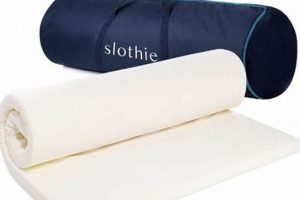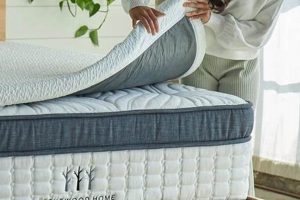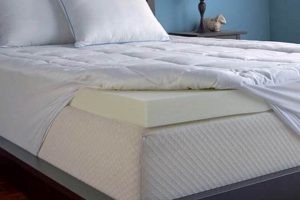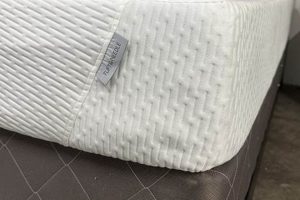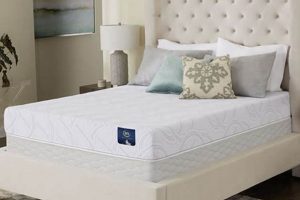The period a viscoelastic foam bed retains its capacity to offer optimal support and comfort is a key consideration for consumers. This duration is influenced by factors such as foam density, usage patterns, and environmental conditions. As an example, a high-density product used by a single individual in a climate-controlled environment will likely have a different serviceable period than a lower-density product used by multiple individuals in a humid environment.
Understanding how long a sleep surface maintains its integrity is paramount for budgeting and ensuring consistent sleep quality. A longer period translates to greater value for money and reduces the frequency of replacement, lessening environmental impact. Historically, bedding was replaced frequently due to materials degrading rapidly; modern materials science has significantly extended usable durations.
The following sections will delve into the determinants affecting the performance lifespan, explore indicators signaling it’s time for a replacement, and offer best practices for maximizing the longevity of your sleep investment.
Extending the Serviceable Period of Viscoelastic Foam Bedding
Maximizing the duration a viscoelastic foam bed provides adequate support and comfort requires diligent maintenance and preventative measures. These strategies can mitigate factors contributing to premature degradation and prolong the product’s usefulness.
Tip 1: Utilize a Supportive Bed Frame: Ensure the bed frame provides adequate support across the entire surface of the mattress. A weak or improperly designed frame can cause uneven weight distribution, accelerating wear in certain areas.
Tip 2: Employ a Mattress Protector: A waterproof and breathable mattress protector safeguards against spills, stains, and dust mites. These contaminants can degrade the foam over time and compromise its structural integrity.
Tip 3: Rotate Regularly: Rotating the mattress 180 degrees every 3-6 months helps to distribute wear more evenly. This practice prevents localized compression and extends the overall lifespan.
Tip 4: Control the Environmental Conditions: Excessive humidity and extreme temperatures can negatively impact the foam’s properties. Maintain a stable and moderate environment in the bedroom.
Tip 5: Vacuum Periodically: Regular vacuuming removes dust, debris, and allergens that can accumulate within the foam. Use a soft brush attachment to avoid damaging the surface.
Tip 6: Follow Manufacturer’s Guidelines: Adhere to the manufacturer’s recommendations regarding cleaning, support, and usage. These guidelines are tailored to the specific foam composition and construction.
By implementing these practices, consumers can optimize the period a viscoelastic foam bed delivers consistent support and comfort, maximizing the initial investment. This proactive approach not only saves money but also reduces the environmental impact associated with frequent replacements.
The subsequent section will provide insights into recognizing signs that a replacement is necessary, ensuring continued sleep quality and support.
1. Foam Density
Foam density is a critical determinant of a viscoelastic foam bed’s serviceable period. Density, measured in pounds per cubic foot (PCF), indicates the quantity of material packed into a given volume. Higher density foams generally exhibit greater resistance to compression and deformation over time, resulting in a longer period of usability. Conversely, lower density foams are more susceptible to breakdown and sagging under consistent pressure. For instance, a 5 PCF foam mattress is likely to outlast a 3 PCF foam mattress under similar conditions and usage patterns, illustrating a direct correlation between material compaction and sustained structural integrity.
The practical significance of understanding this relationship lies in its impact on consumer purchasing decisions. While higher density foams often command a premium price, the extended serviceable period can offset the initial investment. A higher density mattress retains its support and comfort characteristics for a longer duration, reducing the need for premature replacement. Moreover, the density also influences the mattress’s ability to conform to the body and distribute weight evenly. Lower density foams may exhibit premature body impressions, diminishing support and potentially leading to discomfort or pain. The choice of foam density, therefore, represents a trade-off between initial cost and long-term performance.
In summary, foam density directly affects the viscoelastic foam bed’s serviceable period. Increased density is generally associated with enhanced durability, resistance to compression, and sustained support, contributing to a longer useful life. Understanding this principle empowers consumers to make informed decisions, balancing cost considerations with the long-term value and performance of their sleep surface, extending the period before replacement becomes necessary.
2. Usage Frequency
The frequency with which a viscoelastic foam bed is utilized directly impacts its period of optimal performance. Increased usage subjects the foam to greater and more consistent compression, accelerating the breakdown of its cellular structure. This, in turn, diminishes its capacity to provide adequate support and pressure relief. For example, a mattress used daily by one individual will generally exhibit a longer serviceable period than an identical mattress used daily by two individuals or in a commercial setting like a hotel, illustrating the influence of consistent compression on material degradation.
The effect of usage frequency is further amplified by individual weight and sleeping habits. A heavier individual or one who shifts positions frequently during sleep will exert greater stress on the foam, leading to localized compression and a reduction in overall support. Furthermore, the edge of the mattress, frequently used for sitting or getting in and out of bed, tends to experience accelerated wear due to concentrated pressure. Recognizing these factors enables informed decision-making regarding mattress selection and maintenance. For instance, households with multiple occupants might consider investing in higher-density foams or implementing more frequent rotation schedules to mitigate the effects of increased usage.
In summary, usage frequency plays a significant role in determining the period a viscoelastic foam bed provides satisfactory support. Consistent compression and concentrated pressure accelerate material degradation, leading to reduced comfort and functionality. Awareness of this correlation allows for proactive measures to extend the item’s usability, such as selecting appropriate foam densities and implementing regular maintenance practices, ultimately maximizing the initial in
vestment and maintaining sleep quality.
3. Support Structure
The underlying framework upon which a viscoelastic foam bed rests, referred to as the support structure, exerts a considerable influence on its ability to maintain structural integrity and deliver consistent performance throughout its usable duration. An inadequate or improperly matched support system can accelerate wear and compromise the foam’s intended functionality, thereby diminishing its serviceable period.
- Slatted Foundations
Slatted foundations, characterized by evenly spaced wooden or metal slats, provide a common support mechanism. The spacing between the slats is critical; excessive gaps can lead to sagging, as the foam is not uniformly supported. Uneven weight distribution results in localized compression and accelerated wear, ultimately shortening the product’s serviceable time. A properly designed slatted foundation, with appropriately spaced and robust slats, promotes even support, minimizing these issues.
- Solid Platforms
Solid platforms, offering a continuous and unbroken surface, provide arguably the most comprehensive support for a viscoelastic foam bed. The absence of gaps eliminates the risk of sagging between slats, ensuring uniform weight distribution. However, the material composition of the platform is also relevant; a warped or uneven platform will negatively impact the foam’s performance. Solid platforms, typically constructed from wood or reinforced composites, are particularly well-suited for heavier individuals or those seeking maximum support.
- Adjustable Bases
Adjustable bases, allowing for customized positioning, introduce additional complexity to the support structure equation. The segmented design of these bases requires careful engineering to ensure consistent support across all adjustable positions. Inferior adjustable bases may exhibit pressure points or uneven surfaces, leading to localized compression and accelerated wear of the foam. High-quality adjustable bases are designed to maintain uniform support throughout the range of motion, minimizing the risk of premature degradation.
- Box Springs (Compatibility Considerations)
Traditional box springs, while commonly used with innerspring mattresses, are often incompatible with viscoelastic foam beds. The coils within a box spring may not provide the necessary level of uniform support required by the foam, potentially leading to uneven weight distribution and premature sagging. Furthermore, some manufacturers explicitly void warranties when a viscoelastic foam mattress is used with a box spring. Therefore, compatibility with the support structure must be carefully considered to ensure optimal performance and longevity.
The choice of support structure is integral to maximizing the potential period a viscoelastic foam bed provides consistent support and comfort. Selecting a foundation that is both compatible with the mattress type and capable of providing uniform weight distribution is paramount. An appropriate support system mitigates the risk of sagging, localized compression, and accelerated wear, thereby extending the serviceable duration and safeguarding the investment.
4. Environmental Factors
Environmental conditions exert a demonstrable influence on the structural integrity and, consequently, the serviceable period of viscoelastic foam bedding. Temperature fluctuations, humidity levels, and exposure to sunlight or certain chemicals can each contribute to the degradation of the foam’s cellular structure, thereby diminishing its capacity to provide adequate support and comfort. High humidity, for example, can promote the growth of mold and mildew within the foam, compromising its internal composition and potentially leading to premature breakdown. Conversely, prolonged exposure to direct sunlight can cause the foam to become brittle and lose its elasticity, reducing its ability to conform to the body.
The impact of environmental factors can be mitigated through proactive measures. Utilizing a mattress protector not only guards against spills and stains but also provides a barrier against moisture and dust mites, creating a more stable microclimate around the sleep surface. Maintaining a consistent and moderate temperature within the bedroom further reduces the risk of thermal degradation. Additionally, avoiding the use of harsh chemicals or cleaning agents directly on the foam is crucial, as these substances can accelerate the breakdown of the material. In coastal regions characterized by higher humidity levels, dehumidifiers can play a vital role in preserving the longevity of viscoelastic foam bedding.
In summary, environmental conditions are significant determinants of a viscoelastic foam bed’s serviceable period. Uncontrolled temperature fluctuations, high humidity, and exposure to sunlight or harsh chemicals can each contribute to premature degradation of the foam. By implementing preventative measures such as utilizing mattress protectors, maintaining a stable indoor climate, and avoiding harsh chemicals, consumers can mitigate these effects and extend the useful duration of their sleep surface, safeguarding their investment and promoting long-term sleep quality.
5. Maintenance Practices
Consistent and appropriate maintenance practices directly influence the period a viscoelastic foam bed provides optimal support and comfort. The absence of such practices can significantly shorten the product’s serviceable duration, regardless of initial quality or foam density. These actions address factors contributing to material degradation, such as the accumulation of dust mites, the absorption of moisture, and uneven wear patterns. For example, neglecting regular rotation can lead to localized compression in frequently used areas, resulting in premature sagging and a diminished capacity to conform to the body. This, in turn, compromises sleep quality and necessitates earlier replacement.
Implementing a consistent maintenance schedule, including regular vacuuming with an upholstery attachment, mitigates the build-up of allergens and debris within the foam matrix. Employing a waterproof mattress protector safeguards against spills, stains, and the absorption of moisture, preventing the growth of mold and mildew. Rotating the mattress periodically distributes wear more evenly across the surface, minimizing localized compression and extending its usability. Furthermore, adhering to the manufacturer’s recommended cleaning guidelines, using gentle detergents and avoiding harsh chemicals, prevents damage to the foam’s cellular structure. Ignoring these recommendations will reduce the period it last.
In conclusion, the duration a viscoelastic foam bed provides adequate support and comfort is intrinsically linked to the implementation of consistent and appropriate maintenance practices. These actions, while seemingly minor, collectively address factors that contribute to material degradation, thereby extending the product’s serviceable life. Failure to prioritize these practices will inevitably result in premature wear, diminished sleep quality, and the need for earlier replacement, negating
the initial investment and increasing long-term costs. Therefore, proactive maintenance is essential for maximizing the value and extending the functional duration.
6. Manufacturing Quality
The quality of manufacturing processes significantly dictates the potential duration of a viscoelastic foam bed’s usability. Inherent flaws introduced during production can undermine the integrity of the materials, regardless of foam density or maintenance efforts. For example, inconsistent mixing of the chemical components during foam creation can result in uneven cell structure, leading to premature sagging and a reduction in support. Substandard adhesives used in layering the various foam components can delaminate over time, compromising the overall structure of the mattress. Such defects, often undetectable upon initial purchase, manifest as accelerated wear and a shortened serviceable period. Therefore, superior production quality is paramount in ensuring a product achieves its intended lifespan.
The importance of rigorous quality control measures throughout the manufacturing process cannot be overstated. These measures encompass raw material sourcing, foam production techniques, assembly procedures, and final inspection protocols. Reputable manufacturers implement stringent testing procedures to identify and rectify potential defects before products reach consumers. This includes compression tests to assess foam resilience, durability tests to evaluate seam strength, and chemical analyses to ensure compliance with safety standards. Conversely, manufacturers who prioritize cost reduction over quality control risk producing items with inherent weaknesses, directly impacting the viscoelastic foam bed’s potential longevity. A documented history of quality and certifications, as well as material and construction transparency are the surest indicators.
In conclusion, manufacturing quality functions as a foundational element determining how long a viscoelastic foam bed delivers consistent performance. Deficiencies in the production process introduce inherent weaknesses, leading to accelerated wear and reduced lifespan. Choosing a mattress from a manufacturer committed to rigorous quality control is crucial for maximizing the investment and ensuring long-term sleep quality. While initial cost may be a consideration, the extended service period associated with higher production values ultimately provides greater value and reduces the environmental impact associated with premature replacements, as well as offering more restful nights.
7. Weight Distribution
Uneven weight distribution across a viscoelastic foam bed is a primary factor influencing its period of optimal support and comfort. Concentrated pressure in specific areas accelerates foam degradation, leading to localized compression and a reduction in overall support. This effect stems from the nature of viscoelastic foam, which deforms under pressure; sustained, localized pressure compromises the foam’s cellular structure over time. For example, individuals who consistently sleep in the same position or those with significant weight concentrated in the hip or shoulder region often experience premature sagging in those areas. This uneven wear diminishes the item’s overall ability to contour to the body, resulting in discomfort and potentially exacerbating existing musculoskeletal issues. Proper weight distribution is therefore essential for maximizing the item’s longevity and ensuring consistent sleep quality throughout its intended lifespan.
The impact of weight distribution is further amplified by factors such as foam density and support structure. Lower density foams are inherently more susceptible to compression and deformation under concentrated pressure, accelerating wear. Similarly, an inadequate support structure, such as a bed frame with widely spaced slats, fails to distribute weight evenly across the mattress, concentrating pressure in unsupported areas. Addressing these factors requires a multifaceted approach, including selecting higher density foams appropriate for the user’s weight and ensuring the bed frame provides consistent and uniform support. Furthermore, rotating the mattress regularly helps distribute wear more evenly, mitigating the effects of concentrated pressure. Addressing weight distribution proactively in both product selection and maintenance optimizes the viscoelastic foam bed’s ability to maintain its structural integrity over time.
In conclusion, weight distribution represents a critical determinant of a viscoelastic foam bed’s usable life. Concentrated pressure accelerates foam degradation, leading to localized compression and reduced support. Addressing this issue requires a holistic approach encompassing foam density selection, support structure optimization, and proactive maintenance practices. By understanding and mitigating the effects of uneven weight distribution, consumers can extend the serviceable life of their sleep surface, safeguarding their investment and ensuring consistent sleep quality over time, directly influencing its ultimate functional period.
Frequently Asked Questions
The following addresses common inquiries concerning factors influencing the period of optimal support and comfort from viscoelastic foam beds. The intent is to provide clear and concise information to aid in informed decision-making.
Question 1: How long can a viscoelastic foam bed reasonably be expected to last?
The serviceable period varies depending on foam density, usage patterns, and maintenance. High-density foams, under moderate use and with proper care, can last 8-10 years. Lower-density foams may require replacement within 5-7 years.
Question 2: Does foam density directly correlate with longevity?
Yes, a positive correlation exists. Higher density foams exhibit greater resistance to compression and deformation, extending their serviceable period compared to lower density alternatives.
Question 3: Can the bed frame affect the period the mattress lasts?
Indeed. An inadequate or incompatible bed frame can cause uneven weight distribution, accelerating wear and reducing the lifespan of the viscoelastic foam bed. Slatted foundations must have appropriately spaced slats.
Question 4: How does cleaning impact the foam’s period of optimal support?
Improper cleaning can degrade the foam. Harsh chemicals and excessive moisture can damage the cellular structure, shortening the period of the product’s usability. Adhering to manufacturer guidelines is crucial.
Question 5: What role does weight distribution play in determining its lifespan?
Uneven weight distribution concentrates pressure in specific areas, leading to localized compression and accelerated wear. Rotating the mattress periodically helps distribute weight more evenly.
Question 6: Is a mattress protector essential for extending the serviceable period?
Yes. A waterproof and breathable mattress protector shields against spills, stains, dust mites, and moisture, all of which can compromise the foam’s integrity and shorten its life.
Key takeaway: Optimizing the useful duration requires a multifaceted approach encompassing proper selection, appropriate support, diligent maintenance, and mindful usage.
The subsequent section delves
into indicators signaling the need for replacement, ensuring sustained sleep quality.
“memory foam mattress life expectancy”
This exploration has detailed factors influencing how long a viscoelastic foam bed maintains optimal support and comfort. Foam density, usage patterns, support structure, environmental factors, maintenance practices, manufacturing quality, and weight distribution each play a critical role in determining the product’s serviceable period. Diligent consideration of these aspects is crucial for maximizing the investment and ensuring consistent sleep quality.
The understanding of these determinants provides a framework for informed decision-making. Proactive management and appropriate selection extend the usability of these products, and awareness of these factors promotes responsible consumption. By recognizing the importance of these elements, users can both optimize their sleep experience and minimize environmental impact through reduced replacement frequency.


